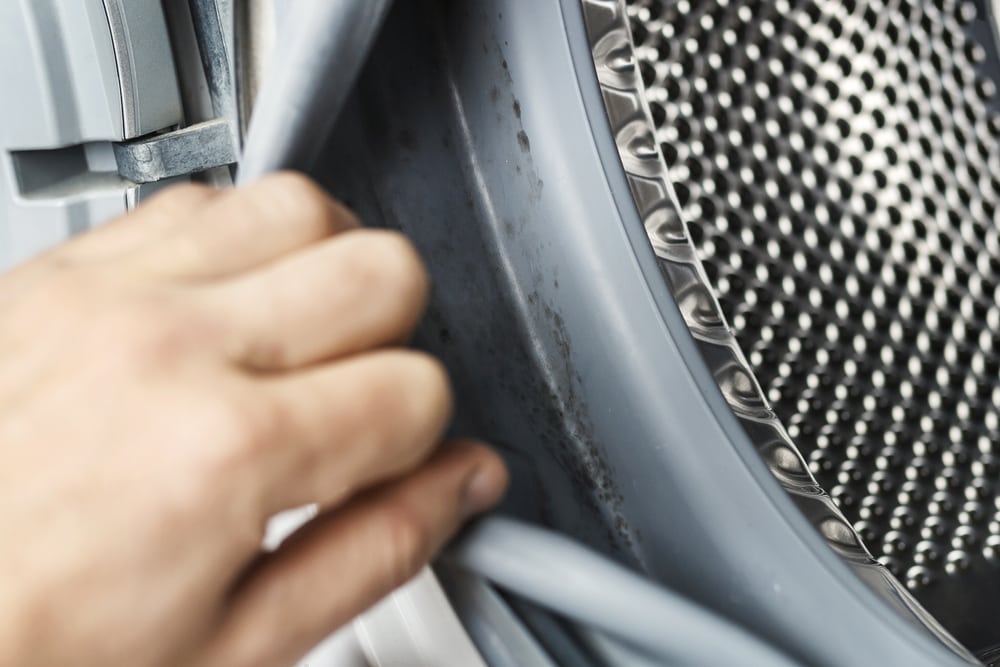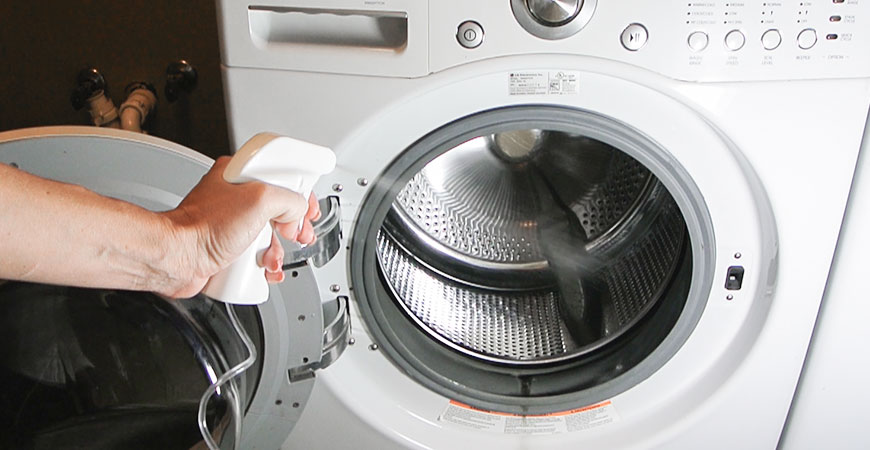Proper care of the automatic type washing machine and periodic maintenance is a guarantee that the household appliance will last a long time and will not require major repairs. Equipment must be kept clean and dry. If the inside is constantly wet, mold may appear on the rubber seal, that is, mold may appear on the cuff of the hatch. Because of this, an unpleasant odor arises, which can also pass to things. The gum becomes covered with dark spots, gradually deteriorates and ceases to perform its main function, which leads to constant leaks during washing. Therefore, the fungus must be removed as soon as possible after its discovery. And take steps to ensure that it does not appear again. Experts from the Expertology online publication will tell you about how to deal with fungus on the sealant of a washing machine.

Preparing to Remove Mold — Necessary Tools and Aids
In order to cope with the task, you will need:
-
cleaning fluid. This can be a remedy prepared according to a folk recipe (we will describe several options below) or a special household chemical preparation. -
Rubber gloves. Use them regardless of whether you use a remedy — prepared yourself or bought at a hardware store. -
New sponge or cloth, which is not a pity to use to wipe the seal, and then throw it away. It is not necessary to store the sponge / fabric after removing the mold until the next cleaning, as there is a risk that the fungus will begin to multiply on it. -
hard washcloth, which will also need to be disposed of after use. Mold can clog into small cracks in the elastic, especially if the washer is old and the cuff has not been changed for a long time. -
Respirator or bandage over the mouth and nose. It is not necessary to use it, but if there is a lot of mold and it emits an unpleasant odor, it is better to protect yourself from it. And just inhaling the spores of the fungus is not good for health.
Having prepared everything you need, you can begin to fight dark spots. Just keep in mind that it is recommended to process not only the rubber of the washing machine, but also the rest of its parts. If the fungus appears on the cuff, then it is better at the same time, at least as a preventive measure, to treat other areas — a tray for washing powder, a filter, a water outlet hose, and the internal mechanism of the device.
What from improvised means can be used
The following tools will help to cope with the problem:
-
Ordinary table vinegar.
-
Lemon acid.
-
Whiteness (it is better to dilute it slightly, by 1/3, with water so that the chlorine liquid is not so concentrated and does not have a negative effect on the rubber of the seal).
-
Hydrogen peroxide.
-
Boric acid diluted with water.
-
Baking soda diluted with water.
The very procedure for removing mold is that first the rubber must be thoroughly washed with a sponge soaped with laundry soap. Leave the foam for 10 minutes and rinse with clean water. Then pour the selected agent onto the sponge, process the sealant, close the door for 15 minutes, rinse. Make sure that the product used only gets on the rubber of the seal, and not on the enamel or paint of the rest of the washer. This treatment is carried out twice in a row. A day later, you can repeat the procedure for a more confident result. The laundry detergent tray is cleaned in the same way. But to clean the hose, the internal mechanism, you will have to do one “idle” wash, use vinegar instead of powder and conditioner.
Using Vinegar
Pour 200 ml into the powder and conditioner container. vinegar. We set the longest washing mode and select the highest temperature. No rinsing or spinning required. After washing, again pour vinegar or citric acid diluted with water into the conditioner compartment, which will leave a pleasant fresh smell. We start the rinse mode. We do repeated rinsing without the use of any means. At the very end, wipe everything inside and out with a dry cloth.
Household chemicals

The choice of such household chemicals is very wide, they are sold in any hardware store. For example, you can use such popular drugs:
-
hg. Mold repellent, which can be used to treat tiles, rubber, silicone. It costs about 4,5 dollars, but you can find cheaper on the Internet. Sold in a spray bottle.
-
Tiret fluid. It is a universal cleaner for the complete treatment of washing machines both inside and out. It costs about 200–3 dollars for 200 ml.
-
Blanidas — 4 dollars for 5 liters.
-
Dr. Beckmann — 5 dollars for a bottle of 500 ml. with a spray bottle.
If household chemicals do not help to remove mold from the rubber seal of the washing machine, you will have to contact the master to replace the part. It is better not to carry out such repairs on your own, since improper replacement of rubber can cause constant leaks during washing.
How to Prevent Mold on Washing Machine Rubber
To prevent mold from settling inside the washing machine, you need to:
-
Periodically clean the drain system of the washing machine, make sure that it is not clogged with anything. If it is difficult to drain the water, water may remain inside the drum after washing. This in itself is bad, as rust may appear on the drum. In addition, in conditions of high humidity, mold just multiplies.
-
Always keep the washing machine door closed. After washing, wipe the drum inside and the rubber of the seal, all accessible places in contact with water, with a dry clean cloth, leave the door open for about half an hour, then close it until the next time. This prevents moisture from getting inside the mechanism and onto the rubber.
-
If you have clothes that can be washed at a high temperature, do this periodically, if possible, by setting 50–60 degrees. Even the most heat-loving fungi (thermophiles) die at a temperature of 37–45 degrees.
Also, experts recommend at least once a week to carefully inspect the washing machine while cleaning the bathroom, because it is easier to fight mold at an early stage of its appearance.

Добавить комментарий
Для отправки комментария вам необходимо авторизоваться.